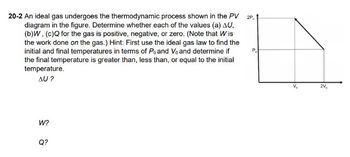Question

Transcribed Image Text:20-2 An ideal gas undergoes the thermodynamic process shown in the PV 2P.
diagram in the figure. Determine whether each of the values (a) AU,
(b)W, (c)Q for the gas is positive, negative, or zero. (Note that Wis
the work done on the gas.) Hint: First use the ideal gas law to find the
initial and final temperatures in terms of Po and Vo and determine if
the final temperature is greater than, less than, or equal to the initial
temperature.
AU?
W?
Q?
V₂₂
2V₂
Expert Solution
This question has been solved!
Explore an expertly crafted, step-by-step solution for a thorough understanding of key concepts.
Step by stepSolved in 2 steps

Knowledge Booster
Similar questions
- 4 di 8 Domanda 8 Completo Punteggio max.: 2 When an ideal gas is compressed isothermally Scegli un'alternativa: A. heat flows into the gas. OB. the internal energy of the gas does not change. OC. the work done on the gas is zero. OD. the temperature of the gas increases. Exam 17-12-2020: Revisione tentativo Domanda 9 O Cerca I https://elearning.unipd.it/dimed/mod/quiz/revien Barrow_forwardThe heat engine shown in the figure uses 2.0 mol of a monatomic gas as the working substance. (Figure 1) Figure p (kPa) 600 400 200 0 0 0.025 0.050 < 1 of 1 V (m³) Part D Determine AEth, Ws, and Q for 3→1. Enter your answers numerically separated by commas. Express your answer using two significant figures. VE ΑΣΦ AEth, Ws, Q = Submit Part E Request Answer What is the engine's thermal efficiency? Express your answer using two significant figures. ? Jarrow_forwardIf we know that the internal energy of the monoatomic ideal gas remains constant during the process in B to C, what must be the pressure Pc at point C in terms of the original pressure P0.arrow_forward
- T14f, please help me with my reviewer, I can’t get the answer for the step 2.arrow_forwardYou would like to raise the temperature of an ideal gas from 295 K to 960 K in an adiabatic process. a)What compression ratio will do the job for a monatomic gas? b)What compression ratio will do the job for a diatomic gas?arrow_forwardA flexible box contains 5.60 grams of nitrogen gas (N2) which is maintained at a constant pressure of 1.35 x 10$ Pa. The box is placed over a fire, causing the volume to increase from 0.00200 m3 to 0.00300 m³. Find the increase in temperature of the gas. (For N2 molar mass M = 28 grams.)arrow_forward
- Only part E required.arrow_forwardConsider ? = 5.00 mol of an ideal diatomic gas successively undergoing each one of the following thermodynamic processes:I. An adiabatic compression from an original volume of 0.150 m3to final volumeof 0.120 m3reaching a temperature of 293.0 K.II. An isothermal expansion to the original volume.III. An isochoric cooling to the original state. A) Draw a pressure-volume diagram showing all these processes.B) Calculate the pressure and temperature for each of the missing principal states.arrow_forward
arrow_back_ios
arrow_forward_ios